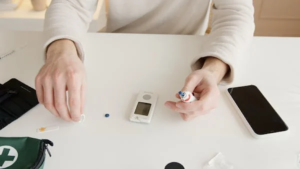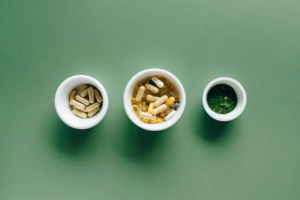Introduction:
Blood sugar spikes can pose significant challenges for individuals managing diabetes. These spikes can lead to symptoms like lethargy, and hunger, and, over time, even contribute to the development and worsening of type 2 diabetes. While you can find valuable information in our free video, this article provides additional measures and tips to help you maintain stable blood sugar levels. Let’s explore ten simple yet effective strategies to keep those spikes at bay.

- Managing Your Caloric Intake for Blood Sugar Control
One effective approach to mitigating blood sugar spikes is to monitor and manage your daily caloric intake, with a particular focus on carbohydrates. Carbohydrates, often referred to as carbs, play a pivotal role in influencing blood sugar levels. When you consume carbs, they undergo a breakdown process, ultimately transforming into simple sugars that enter your bloodstream. If you are already adhering to a reduced-calorie diet, further reduction may prove beneficial in controlling potential blood sugar spikes. You learn how to count and manage your calories in an upcoming blog.
- Steer Clear of Artificial Sweeteners
While artificial sweeteners may not have an immediate impact on your blood sugar, prolonged use can potentially worsen your diabetes over time. Instead, consider incorporating minimal amounts of naturally sweet alternatives like blended prunes, raisins, blue agave, or honey to add flavour to your food. Gradually, aim to recalibrate your taste buds to appreciate foods without the need for sweeteners.
- Strategic Food Combinations
Enhancing your meals with low-glycemic foods can effectively lower the overall glycemic index by delaying the absorption of nutrients. Consider including legumes like peas and beans, nuts, seeds, and vegetables in your diet. Blending these vegetables can be especially beneficial. Chia seeds and ground or blended flaxseed are excellent choices for this purpose. Additionally, a small amount of healthy oil, such as virgin olive oil or oil-rich foods like nuts, can help achieve this effect. However, it’s crucial to remain mindful of your caloric intake and adhere to your dietary restrictions. Glycemic index will be discussed in the next blog.
- Mindful Fruit Selection
It’s important to be discerning when it comes to fruit choices, especially if you’re concerned about blood sugar spikes. Exceptionally sweet fruits, particularly when fully ripe, often contain higher sugar content. Opting for fruits that are less sweet can be a wise strategy, as they are less likely to lead to sudden blood sugar spikes.

- Increase Fiber Intake
Incorporating more fibre into your diet is an effective strategy to reduce the rate at which sugar is absorbed into your bloodstream, thus helping to prevent blood sugar spikes. While the previously recommended diet already emphasizes a high fibre intake, you can further enhance the fibre content if necessary. Additionally, increasing your fibre consumption can have the added benefit of improving the health of your gut bacteria, which, over time, can positively impact your blood sugar control. Excellent sources of dietary fibre include vegetables, prunes, glucomannan, psyllium seeds, and xanthan gum. Switching to a plant-based diet will increase your fibre intake. This be discussed in an upcoming blog.
- Embrace More Physical Exercise
Physical exercise plays a pivotal role in managing blood sugar spikes by enhancing the sensitivity of your cells to the hormone insulin. It triggers your muscle cells to efficiently absorb sugar from the bloodstream, thereby assisting in reducing blood sugar levels. Engaging in a post-meal walk, for instance, can be particularly beneficial in this regard. If you’re already incorporating some physical activity into your routine, increasing the frequency and intensity of exercise may further contribute to lowering your blood sugar level.

- Unlocking the Benefits of Retrogradation
Another effective strategy for managing blood sugar spikes involves a process known as retrogradation. This technique entails cooking food and then allowing it to cool overnight, a practice that can significantly lower the food’s glycemic index (GI) and subsequently reduce the impact on your blood sugar levels. The science behind this lies in the formation of bonds between food molecules during the cooling process, which in turn slows down the breakdown of carbohydrates in the food, resulting in a more gradual release of sugars into your bloodstream.
- Optimal Food Preparation
Foods with coarser textures tend to have a lower GI. For instance, using cornmeal with larger particles can result in a slower digestion process, which can help stabilize blood sugar levels. Also, less cooking time and lower cooking temperature can keep the glycemic index down. If you’re open to it, consider incorporating raw versions of certain foods like oatmeal and ripe plantains into your diet. Raw foods often have a lower GI compared to their cooked counterparts.
- Incorporate Vinegar Wisely
An effective technique for moderating blood sugar spikes involves incorporating vinegar into your meals. By simply adding two tablespoons of vinegar to your meal, you can slow down the absorption of sugars, which can help reduce the subsequent blood sugar spike. Apple cider vinegar is a popular choice due to its palatability, making it a convenient option for those looking to manage their blood sugar levels more effectively.
- Exploring the Potential of Supplements
In addition to dietary and lifestyle modifications, supplements can also play a role in mitigating blood sugar spikes. Several studies suggest that supplements like berberine, chromium, fenugreek, cinnamon, and magnesium may have a positive impact on blood sugar control. You may obtain any of these supplements by following the embed link. They offer a complementary approach to your diabetes management regimen and can be considered in consultation with your healthcare provider to help maintain stable blood sugar levels. These supplements will be further discussed in another blog.

Regular Blood Sugar Monitoring
Consistently monitoring your blood sugar levels is a crucial step in effectively managing your diabetes. Regular checks empower you to identify patterns and make informed adjustments to your diet and lifestyle as necessary. Ensure that you have an adequate supply of your preferred monitoring equipment to maintain consistency in tracking your blood sugar levels.
Conclusion
Preventing blood sugar spikes is within your reach through strategic changes in your diet and lifestyle. By implementing these straightforward tips, you can maintain stable blood sugar levels, reduce the risk of complications, and prioritize your long-term health.


Thank you doctor.
Practical suggestions. I will be implementing diet changes and work on my sleep and water.